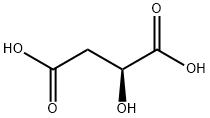| Description |
L-Malic acid is nearly odorless (sometimes a faint, acrid odor) with a tart, acidic taste. It is nonpungent. May be prepared by hydration of maleic acid; by fermentation from sugars. |
| Chemical Properties |
L-Malic acid is nearly odorless (sometimes a faint, acrid odor). This compound has a tart, acidic, nonpungent taste. |
| Chemical Properties |
clear colourless solution |
| Occurrence |
Occurs in maple sap, apple, melon, papaya, beer, grape wine, cocoa, sake, kiwifruit and chicory root. |
| Uses |
L-Malic acid is used as a food additive, Selective α-amino protecting reagent for amino acid derivatives. Versatile synthon for the preparation of chiral compounds including κ-opioid receptor agonists, 1α,25-dihydroxyvitamin D3 analogue, and phoslactomycin B. |
| Uses |
The naturally occuring isomer is the L-form which has been found in apples and many other fruits and plants. Selective α-amino protecting reagent for amino acid derivatives. Versatile synthon for the preparation of chiral compounds including κ-opioid rece |
| Uses |
Intermediate in chemical synthesis. Chelating and buffering agent. Flavoring agent, flavor enhancer and acidulant in foods. |
| Definition |
ChEBI: An optically active form of malic acid having (S)-configuration. |
| Preparation |
L-Malic acid can be prepared by hydration of maleic acid; by fermentation from sugar. |
| General Description |
L-Malic acid is an organic acid that is commonly found in wine. It plays an important role in wine microbiological stability. |
| Biochem/physiol Actions |
L-Malic acid is a part of cellular metabolism. Its application is recognized in pharmaceutics. It is useful in the treatment of hepatic malfunctioning, effective against hyper-ammonemia. It is used as a part of amino acid infusion. L-Malic acid also serves as a nanomedicine in the treatment of brain neurological disorders. A TCA (Krebs cycle) intermediate and partner in the malic acid aspartate shuttle. |
| Purification Methods |
Crystallise S-malic acid (charcoal) from ethyl acetate/pet ether (b 55-56o), keeping the temperature below 65o. Or dissolve it by refluxing in fifteen parts of anhydrous diethyl ether, decant, concentrate to one-third volume and crystallise it at 0o, repeatedly to constant melting point. [Beilstein 3 IV 1123.] |









